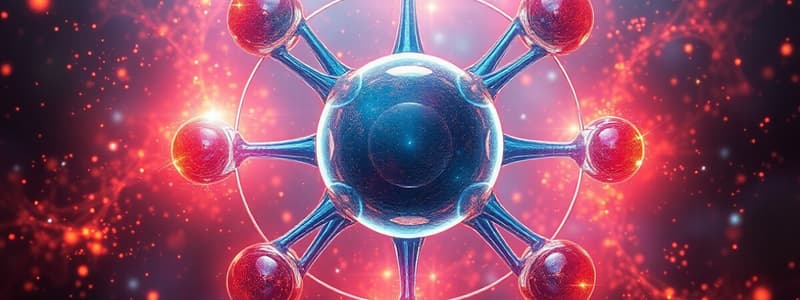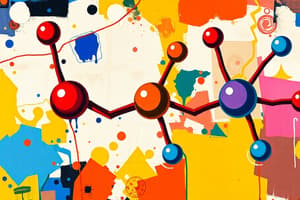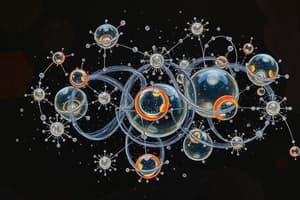Podcast
Questions and Answers
What determines the identity of an atom?
What determines the identity of an atom?
- The number of protons (correct)
- The mass number
- The number of electrons
- The number of neutrons
Which statement accurately describes the mass of protons and neutrons?
Which statement accurately describes the mass of protons and neutrons?
- Protons and neutrons both have a mass of 1 (correct)
- Protons have a mass of 1 and neutrons have a negligible mass
- Only neutrons have a mass of 1
- Both protons and neutrons have a mass of approximately 0.0005
How does the ratio of neutrons to protons influence an atom?
How does the ratio of neutrons to protons influence an atom?
- It identifies the element
- It affects the stability of the nucleus (correct)
- It determines the atomic number
- It dictates the charge of the atom
What is true about isotopes of an element?
What is true about isotopes of an element?
What does the mass number represent on the periodic table?
What does the mass number represent on the periodic table?
What describes the primary characteristic of elements?
What describes the primary characteristic of elements?
What was a key contribution of John Dalton to atomic theory?
What was a key contribution of John Dalton to atomic theory?
Which model of the atom introduced the concept of a nucleus?
Which model of the atom introduced the concept of a nucleus?
Which subatomic particle is negatively charged?
Which subatomic particle is negatively charged?
In Niels Bohr's atomic model, what keeps electrons in orbit around the nucleus?
In Niels Bohr's atomic model, what keeps electrons in orbit around the nucleus?
Which particle is responsible for the mass of an atom?
Which particle is responsible for the mass of an atom?
What did JJ Thomson discover about electrons?
What did JJ Thomson discover about electrons?
Which atomic model represents electrons being held in specific pathways around the nucleus?
Which atomic model represents electrons being held in specific pathways around the nucleus?
What is the chemical formula of methane gas?
What is the chemical formula of methane gas?
How many hydrogen atoms are covalently bonded to a single carbon atom in methane?
How many hydrogen atoms are covalently bonded to a single carbon atom in methane?
What is a characteristic of covalent bonds as seen in hydrogen and carbon bonding in methane?
What is a characteristic of covalent bonds as seen in hydrogen and carbon bonding in methane?
In the covalent bonding of methane, how are the electrons distributed?
In the covalent bonding of methane, how are the electrons distributed?
What is the ratio of carbon to hydrogen in methane gas?
What is the ratio of carbon to hydrogen in methane gas?
Which statement accurately describes the structure of methane gas?
Which statement accurately describes the structure of methane gas?
In covalent bonding, what does the term 'valence shell' refer to?
In covalent bonding, what does the term 'valence shell' refer to?
Which type of electron interaction is primarily represented in the bonding of ammonia?
Which type of electron interaction is primarily represented in the bonding of ammonia?
What is the bonding type present in chlorine gas (Cl2)?
What is the bonding type present in chlorine gas (Cl2)?
How many valence electrons does a neutral chlorine atom possess?
How many valence electrons does a neutral chlorine atom possess?
What is the chemical formula for chlorine gas?
What is the chemical formula for chlorine gas?
When chlorine atoms bond, what do they form?
When chlorine atoms bond, what do they form?
How many electrons are involved in a double covalent bond?
How many electrons are involved in a double covalent bond?
How many electrons are needed by an oxygen atom to achieve a full outer shell?
How many electrons are needed by an oxygen atom to achieve a full outer shell?
What type of bond is formed between two oxygen atoms in O2?
What type of bond is formed between two oxygen atoms in O2?
Which element needs four additional electrons to achieve a full outer shell?
Which element needs four additional electrons to achieve a full outer shell?
What does 'sharing an electron' refer to in covalent bonding?
What does 'sharing an electron' refer to in covalent bonding?
What is the structure of the outer electrons for a neutral oxygen atom?
What is the structure of the outer electrons for a neutral oxygen atom?
Who proposed the concept of covalent bonding?
Who proposed the concept of covalent bonding?
In what configuration does a neutral chlorine atom arrange its electrons?
In what configuration does a neutral chlorine atom arrange its electrons?
Which element requires one more valence electron to achieve stability?
Which element requires one more valence electron to achieve stability?
What does a straight line represent in a covalent bond diagram?
What does a straight line represent in a covalent bond diagram?
Flashcards are hidden until you start studying
Study Notes
Atomic Structure
- Atoms are made up of three subatomic particles: protons, neutrons, and electrons.
- Protons and neutrons are found in the nucleus of an atom and are relatively heavy.
- Electrons orbit the nucleus and are very light.
- The number of protons determines the type of atom.
- Number of protons and neutrons together determine the mass of an atom.
- Ratio of protons to electrons determines the net charge of an atom.
- The ratio of neutrons to protons determines the stability of an atom.
- Isotopes are atoms of the same element (same number of protons) that have a different number of neutrons.
Covalent Bonding
- A covalent bond forms when two atoms share one or more pairs of electrons.
- Each atom contributes one or more electrons to the shared pair.
- Covalent bonds usually occur between non-metal atoms.
- When atoms share electrons, they achieve a full outer shell, making them more stable.
- A single bond is formed by one pair of electrons, a double bond by two pairs, and a triple bond by three pairs.
Examples of Covalent Bonding
- Chlorine Gas (Cl2): Each chlorine atom has 7 valence electrons and needs one more to achieve a full outer shell. They share one pair of electrons, forming a single covalent bond.
- Oxygen Gas (O2): Each oxygen atom has 6 valence electrons and needs two more to achieve a full outer shell. They share two pairs of electrons, forming a double covalent bond.
- Methane Gas (CH4): Carbon has 4 valence electrons and needs four more. Hydrogen has 1 valence electron and needs one more. Carbon shares one electron with each of the four hydrogen atoms, forming four single covalent bonds.
Studying That Suits You
Use AI to generate personalized quizzes and flashcards to suit your learning preferences.




